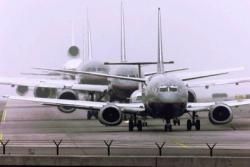Outsourcing Costs Skyrocket Over 2000 Figures
 US scheduled passenger airlines may employ more workers than
ever... but it seems fewer of them are responsible for
actually keeping planes in the air. The Department of
Transportation announced Tuesday US carriers employed four percent
fewer pilots and 32 percent fewer maintenance workers in 2007 than
in 2000, citing figures from DOT's Bureau of Transportation
Statistics.
US scheduled passenger airlines may employ more workers than
ever... but it seems fewer of them are responsible for
actually keeping planes in the air. The Department of
Transportation announced Tuesday US carriers employed four percent
fewer pilots and 32 percent fewer maintenance workers in 2007 than
in 2000, citing figures from DOT's Bureau of Transportation
Statistics.
The seven large network carriers employed 29.9 percent fewer
pilots and 42.6 percent fewer maintenance workers in 2007 than in
2000. The six low-cost carriers now operating employed 24.2 percent
more pilots and 2.1 percent more maintenance workers from 2000 to
2007.
United Airlines had the largest reduction in pilots of any
network airline from 2000 to 2007, while Alaska Airlines was the
only network airline to add pilots during that time. Northwest
Airlines had the largest reduction in maintenance workers of any
network airline; Alaska and Continental Airlines were the only
network carriers to add maintenance employees during that time.
All US low-cost carriers added pilots from 2000 to 2007. JetBlue
Airways had the largest increase while Frontier Airlines had the
smallest gain. JetBlue also had the largest increase in maintenance
workers of any low-cost airline from 2000 to 2007, while Spirit
Airlines had the only reduction.
Overall, the seven network carriers employed 13.5 pilots per
aircraft in 2007, down from 15.0 pilots per aircraft in 2000. The
low-cost carriers employed 11.1 pilots per aircraft in 2007, down
from 13.3 pilots per aircraft in 2000 even though all of the
low-cost carriers added pilots from 2000 to 2007.
Northwest had 12.4 pilots per aircraft in 2007, down from 14.2
per aircraft in 2000, the fewest of any network airline. United,
with 14.7 per aircraft, down from 18.8 per aircraft in 2000, had
the largest decline in the number of pilots per aircraft from 2000
to 2007 but still had the most pilots per aircraft of any network
carrier. Continental, which had the fewest pilots per aircraft of
any network carrier in 2000, was the only one of the group to have
more pilots per aircraft in 2007 than in 2000.
 As for maintenance personnel,
passenger airlines had 8.3 maintenance workers per aircraft in
2007, down from 13.0 per aircraft in 2000. The network airlines had
12.3 maintenance workers per aircraft in 2007, down from 16.6 per
aircraft in 2000.
As for maintenance personnel,
passenger airlines had 8.3 maintenance workers per aircraft in
2007, down from 13.0 per aircraft in 2000. The network airlines had
12.3 maintenance workers per aircraft in 2007, down from 16.6 per
aircraft in 2000.
Not surprisingly, over the same period spending by network
airlines for outsourced maintenance increased from 29.6 percent of
total maintenance spending in 2000, to 45.3 percent in 2007.
The low-cost airlines had 3.6 maintenance workers per aircraft
in 2007, down from 5.2 per aircraft in 2000. Spending by low-cost
airlines for outsourced maintenance increased from 52.0 percent of
total maintenance spending in 2000 to 54.2 percent in 2007.
Northwest had 0.8 maintenance workers per aircraft in 2007, the
fewest of any network airline and down from 13.9 employees per
aircraft in 2000. Northwest's spending for outsourcing increased
from 23.8 percent of total spending in 2000 to 71.0 percent in
2007.
American Airlines had 22.4 maintenance workers per aircraft in
2007 -- the most of any network airline and up from 21.4 employees
per aircraft in 2000, though American's spending percentage for
outsourcing remained constant at 23.4 percent.
 ANN's Daily Aero-Linx (04.16.24)
ANN's Daily Aero-Linx (04.16.24) Aero-News: Quote of the Day (04.16.24)
Aero-News: Quote of the Day (04.16.24) Airborne 04.10.24: SnF24!, A50 Heritage Reveal, HeliCycle!, Montaer MC-01
Airborne 04.10.24: SnF24!, A50 Heritage Reveal, HeliCycle!, Montaer MC-01 Airborne 04.12.24: SnF24!, G100UL Is Here, Holy Micro, Plane Tags
Airborne 04.12.24: SnF24!, G100UL Is Here, Holy Micro, Plane Tags Airborne-Flight Training 04.17.24: Feds Need Controllers, Spirit Delay, Redbird
Airborne-Flight Training 04.17.24: Feds Need Controllers, Spirit Delay, Redbird




